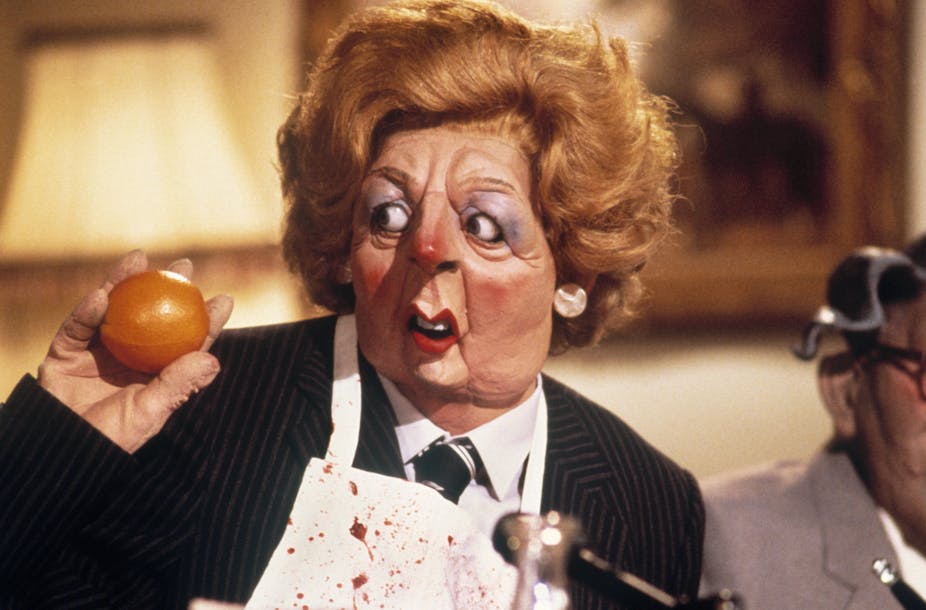Spitting Image, first broadcast in February 1984, is famed as an iconoclastic satire of 1980s political and popular culture. Its grotesque puppet caricatures became so well known that they could cement a person’s image in public consciousness: Margaret Thatcher as a domineering bully, Sarah Ferguson a snorting Sloane ranger, a grey-skinned John Major joylessly chomping a plate of peas.
Thatcher may have provided the show with its star turn, but her government’s policies were also influential in bringing the programme to air, as well as its eventual demise. The story of Spitting Image is a surprisingly – and accidentally – Thatcherite one.
Spitting Image had unusual origins for a popular TV show. It began with the partnership of artists Roger Law and Peter Fluck, also known as “Luck and Flaw”. They specialised in three-dimensional caricature models, which were photographed for news outlets across the world.
To provide additional income, the pair decided to make these models move. Though Fluck and Law would not have called themselves entrepreneurs, they were keen to expand the operation in ways that would have made Thatcher happy.
At a feted “original lunch” in 1982, designer Martin Lambie-Nairn suggested a television show as a vehicle for Fluck and Law’s caricaturing. They formed an independent company with US-based satirist Tony Hendra, comedy producer John Lloyd (who had approached Fluck and Law to animate their caricatures for his hit BBC show Not the Nine O’Clock News) and freelance current affairs producer Jon Blair.
It was unclear, though, how to translate this wealth of knowledge, experience and enthusiasm into making and selling a TV show.
This was understandable, since, at this time, most British TV was made in-house, either by the BBC or within the ITV network. Independent television production was a cottage industry and indies had little access to airtime.

Spitting Image would need to be made with a major broadcaster, but most commissioners were unwilling to take this expensive risk. Charles Denton of Central Independent Television (CIT) was the exception. He was looking for opportunities to change the image of CIT, which was largely known for light entertainment.
Spitting Image was offering something different: it was innovative, provocative, eye-catching.
After a successful 20-minute pilot produced in June 1983, Denton enthusiastically commissioned Spitting Image to begin in 1984. It became a rare example for its time of a co-production between ITV and an independent production company.
The enterprise zone
After teething troubles, Spitting Image grew into hit for CIT. There was huge demand for the puppets, which were manufactured in “the world’s first caricature sweatshop”, as Law jokingly described it in a 1985 documentary.
The workshop was in London’s West India Dock (now Canary Wharf) one of the government’s newly founded “Enterprise Zones”, which gave tax incentives and relaxed regulations for redevelopment. These aided the refurbishment of the Spitting Image “factory”.
Spitting Image became a ubiquitous part of 1980s popular culture. The puppets appeared on a wide range of merchandise, including books, board games, records and toys.
Spin-offs boosted the reputation of the show, though arrangements were ad hoc, and the creative team were ambivalent about them, keen to avoid selling out.
The international success of the series helped to boost its reputation. Not only did it win awards such as the International Emmy in 1986, but it would be imitated around the world, for example as Les Guignols de L’Info in France or Kukly in Russia. Its success in international sales led in 1989 to it winning a Queen’s Award for Export Achievement.
Political objections to the Thatcher government notwithstanding, Spitting Image was heralded as one of the commercial success stories for the UK TV industry at this time. Its annual turnover was reported at over £2 million in 1986.
The show’s decline
Thatcher’s resignation in November 1990 deprived Spitting Image of its main character. But her government’s television policy had already sowed the seeds for the series’ demise.
Thatcher saw the TV industry as bloated, bureaucratic and dominated by unions. She called ITV the “last bastion of restrictive practices” in 1987. Her overall aim was to marketise broadcasting by introducing greater competition. The prize of a privatised BBC eluded her.
Legislation was passed in 1990 that required the BBC and ITV to commission 25% of its programming from independent production companies. Uncertainty about how this would work caused costly delays in commissioning decisions in the early 1990s, which led to difficulties for Spitting Image Productions.
Licenses to run (and profit from) regional ITV franchises were now awarded to the highest cash bid. ITV companies became more explicitly profit-oriented, and programmes were under greater pressure to deliver audiences to advertisers. This coincided with a recession in 1990 and 1991, which depressed demand for advertising and raised operating costs thanks to inflation.
By the early 1990s, Spitting Image’s ratings were in decline. Most of the original creative team had left. Other ventures, such as a Madame Tussauds-style Rubberworks exhibition or children’s TV show The Winjin’ Pom, had not generated much needed extra income. The final series aired in 1996.
Spitting Image has since been revived. In 2020 and 2021 it was brought back as exclusive content for the streaming service Britbox, and then in 2023 as a musical staged in Birmingham and London.
But it is as a silly, rude, satirical vision of the 1980s – and a unique product of a changing television industry – that it will be remembered.

Looking for something good? Cut through the noise with a carefully curated selection of the latest releases, live events and exhibitions, straight to your inbox every fortnight, on Fridays. Sign up here.

